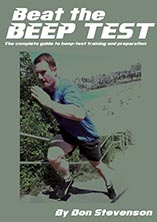Military Fitness – Part 41


When it comes to developing maximal strength for military fitness there are a handful of basic exercises that form the core of every program I write. In previous articles I’ve covered squats, deadlifts and pullups, so now it is time to cover bench pressing and overhead pressing.
When it comes to strength training no exercise is more popular than the bench press. It is a running joke among trainers and serious strength athletes that every Monday is “International Bench Press Day” when the gym is packed with guys pumping their pecs, before mysteriously going AWOL before the hard work of leg day.
 Beat The Beep Test by Don Stevenson is an 89-page complete e-guide to beep-test training and preparation.
Beat The Beep Test by Don Stevenson is an 89-page complete e-guide to beep-test training and preparation.
20% of proceeds from the sale of this e-book will be donated to Soldier On
The obsession with bench pressing and curls leads to a lot of injuries and can cause issues that will actually hinder your military fitness. So, if you are going to bench (and I know you are) please keep the following in mind;
- A big bench is impressive, but a big overhead press is just as important and more functional from a military perspective.
- If you are going to do a lot of bench then you have to balance it out with a lot of unsexy back work to avoid injuries. Seated row, dumbbell row and chin-ups – at least one rep of back for every rep of bench, no excuses!
- Upper body pressing is not just an upper-body exercise. To be a good presser, it helps to have a strong core, so suck it up and do some core work too.
- Stretch! Benching can make you tight in the chest and shoulders, limiting your ability to get your arms into useful positions.
- For military fitness there is no need to employ advanced powerlifting techniques such as a huge arch in the bench.
- For bench press, use a power rack or spotter – people die every year from getting pinned.
Now that we’ve covered that, let’s look at some tips for becoming a better presser and then I’ll outline a couple of techniques and program ideas that will push your press numbers up.
Tips for both presses
- Create a stable base – when pressing, it is important to realise that while your chest, shoulders and triceps are moving the weight, they can’t do so effectively if the rest of your body is softer than hotbox pasta. Make sure you plant your feet firmly on the ground (no dead-bug pose on the bench!), brace your abs and set your back in a neutral posture. In the bench press, your head, shoulder blades and glutes should touch the bench and your feet should push into the floor.
- Take a deep breath and hold it – intra-abdominal pressure stabilises the spine and signals to your body that something important is going on. Breathe in during the lowering phase of the press and hold your breath until you are past the sticking point.
- Crush the bar – as with breathing, trying to crush the bar activates stabiliser muscles and signals to the body that maximum effort is needed.
- Don’t compromise technique for weight. Every week at my gym I watch two guys who load up the bar with too much weight and then proceed to do bench presses that are higher than Snoop Dogg. For months now they have not gotten any stronger or more muscular. Bury your ego and press all the way from your chest to full lockout each rep, even if it means only one 20kg plate per side instead of two.
Programming
In general, to avoid stagnation, it is important to rotate between different loading parameters over the course of a week or month rather than just banging away at three sets of 10 for months on end.
Typically I advise two sessions a week of each press with the following format (I’m going to use a theoretical one-rep max of 100kg to illustrate)
Day 1 –
Heavy Day – work up to a single rep at 90kg then do 3 x 5 reps at 80-85kg. Each week increase the weights by 2.5kg. Dumbell rows for 3 x 10.
Day 2 –
Rep day – warm up and then do 3 x 8 with 70-75kg. Each week add a rep or two until you can do 3 x 12. Pullups for six sets of max reps.
After 4-6 weeks retest your max and reset the percentages.
On the same day as bench, I normally program squats, and on the overhead-pressing day I program deadlift.
Once you can bench at least 75% of your bodyweight for women or 100% of bodyweight for men for a solid set of eight reps (50% and 75% respectively for overhead) then you can explore advanced techniques such as some forced reps.
.
.
.
.
.
.

.
.






